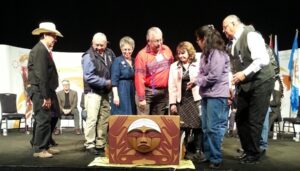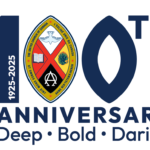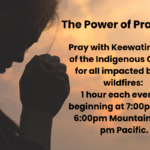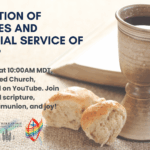By Rev. Cecile Fausak
Elder Charles began his journey to the spirit world on December 17, 2023. We miss him, and will strive to carry forward his teachings.
 He was always saying that we have to work together.
He was always saying that we have to work together.
Even though he was a survivor of Blue Quills residential school and had experienced discrimination in many forms, he agreed to help me bring Indigenous and church people together.
I can hardly remember how I met him, but sometime in 2009, I had approached the United Church minister in Saddle Lake asking him for a recommendation of an Indigenous person to join our regional Living into Right Relations Group from that congregation. Rev. Robert Wright suggested the name of Charles Wood, who was not from any United Church congregation. Charles was brought up Roman Catholic and continued to attend the local parish and keep in touch with priests who had served in the area – one in particular had gone on to work at the Vatican.
But what was important was that he sought to overcome the divisions on the reserve between Roman Catholic and United Church followers. One of his best friends was Floyd Steinhauer who was a leading elder in the Saddle Lake United Church. Together they worked to bring people together in caring for each other; they said it was okay for people to intermarry, as indeed Floyd had done.
At that time, I lived in Athabasca. Gratefully, it came to be that Elder Charles Wood agreed to provide advice and participated in a KAIROS Blanket Exercise that I was wanting to facilitate with about 40 people from the United Church in Alberta. It is an experiential learning exercise to portray the history of the interactions of Indigenous and European peoples on Turtle Island from point of contact. Charles would share stories of how say the pass system had affected his family – his father would haul grain or cattle at night to sell them as he was not supposed to be able to sell off-reserve. And how is father tried to keep him out of residential school but was threatened with prison.
As I visited Saddle Lake Cree Nation and other communities from which children were taken to go to the Red Deer Indian Industrial School, and we met in September 2009 to plan how we would remember the children who had died at that school between 1893 and 1919, Charles provided so much sound guidance, always saying we have to work together. He referred to all of us around the table – church folks of all denominations; Cree, Stoney, Metis of all clans; government officials and museum staff.
At the first feast at Fort Normandeau to remember the children and set their spirits free, we read over 325 names of all the children who had attended the Red Deer Indian Industrial School. The whispers of relatives’ surprised and sad recognition mingled with those of the June breezes and the rippling Red Deer River. Charles in his signature red vest with appliqued medicine wheels and feathers was a solid comforting presence as he helped young people give tokens of prayer to any descendants who identified themselves. He was always mindful of teaching and including youth in the ceremonies.
When we all formally came together in 2011 to form the Remembering the Children Society, it was Charles who was the first President, and I kept copious notes of the Board’s discussions and decisions. The Society also wanted to educate and commemorate alongside the feasts (a small contingent at the cemetery, and then a gathering for as many as would come at another venue). Charles helped us negotiate a good way forward to lodge four wooden grave headboards from the school cemetery with the Red Deer Museum. He was one of the designated Resolution Health Support Workers to provide cultural support whenever survivors gathered and might likely experience emotional triggering.
At the third gathering on the grounds of Sunnybrook United Church, there was a time when several people recalled stories that their parents or grandparents had shared about their time at RDIIS. In the fourth year, we planned the fourth feast as the culmination of a Truth and Reconciliation Commission hearing conducted at the Red Deer College. It was a major undertaking that Charles emceed with exceeding calm, respect and dignity. We trusted one another to help the various parts of the program, including the involvement of 2000 school children, to run smoothly.
It was a treat to visit and stay overnight with Charles and his beloved wife Mary in their Saddle Lake home, the walls a gallery of family and community, the past and the present. I was floored that they had endured the loss of three sons – how do parents walk so strongly, standing up for their people, when they have been dealt such severe blows? In their custom, hosts are so honored to have you stay in their homes, that they give you a gift – the opposite of British culture. To this day, I proudly wear a beaded medallion necklace they gave me. In the centre is a green turtle in the earth – seven ‘diamonds’ surround it, representing the seven sacred teachings: love, respect, honesty, courage/bravery, truth, wisdom and humility. If we take these teachings to heart, we will have the strength and faith to get through any struggle.
Miyo wicehtotan: Let us Live in Peace
In the spring of 2011, St. Stephen’s College of the United Church offering post-secondary theological education to lay and clergy alike invited Charles and I to speak in Edmonton, Red Deer, and Calgary to help prepare the ground for the arrival of the TRC. Charles readily agreed, proposing the theme “Miyo wicehtotan: Let us Live in Peace”. The publicity said “This presentation will focus on building bridges and a basis for healing and reconciliation between Indigenous peoples and the settlers and immigrants who came to Turtle Island. Treaties and apologies, the Indian Residential School Settlement Agreement including the Truth and Reconciliation Commission, historical injustices, and the United Church’s endeavours to live out its apology and into right relations will be addressed.”
That was a tall order! It was important that Charles start, and speak for as long as he needed, more than half of the designated time. He was inspiring. Listeners always left with the hope that reconciliation was possible, step after step. Our birthdays were 14 years and 2 days apart. He began all this travelling with me at about the same age I am now – 71. Charles was always thinking about where he should direct his energy, what efforts were most important to support at the moment. With a mentor like that, I guess it’s not time to hang up my walking shoes yet.
At the National TRC Event in Edmonton in March 2014, it was a great honour to share the story of the Remembering the Children Society and place a memento into the Bentwood Box as a symbol of the reconciliation that happened amongst several First Nations communities, the Metis Nation of Alberta, and the United Church of Canada.

Richard Lightning, Cecile Fausak, Charles Wood, and Muriel Stanley Venne presented the Society’s expression of reconciliation for TRC Bentwood Box to Wilson Littlechild on far left and ? and Eugene Arcand on right
In Ottawa, in June 2015, when the TRC Final Report was to be presented, I went to see the Witness Blanket exhibit at City Hall. On behalf of the Society, Charles had presented a sandstone brick from the RDIIS to be incorporated into that amazing art installation with artifacts from nearly every residential school in Canada. Who should be standing by the entrance but Charles and his grandson, who immediately shed his backpack and began rummaging in it. Out came a soft white doe-skin like vest, finely embroidered with soft blue, pink, and lilac flowers on the front panels, and a fleur de lis cross on the back. For me! I’m still overcome at the effort made to present this gift to me. I still have so much to learn about extending surprising generosity.
Charles also always said “I don’t care how you pray, just that you pray” whenever he lit the smudge and passed the bowl around in our church circles. I was told once that the closest Cree word to ‘minister’ was ‘one who prays’. I’m still learning about the importance of daily, unceasing prayer. It’s time to initiate a beautifully hand-painted hanging smudge bowl that I was gifted after speaking at a reconciliation event at Blue Quills College.
The foundations and success of the Living into Right Relations work of the United Church in Alberta and Treaty 6,7 and 8 owe much to Charles’ openness, grace, and willingness to work alongside his Protestant siblings in the Spirit. Great prayers of thanksgiving rise.
Written October 2023, revised December 20, 2023
Rev. Cecile Fausak, Lacombe, AB
Chinook Winds and Northern Spirit Regional Councils, and the Being Good Relations Network





